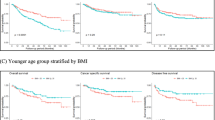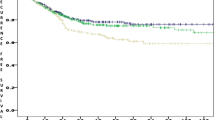Abstract
Purpose
To evaluate the association between body mass index (BMI) and oncological outcomes in patients treated with radical nephroureterectomy (RNU) for upper tract urothelial carcinoma (UTUC).
Methods
We retrospectively reviewed 237 consecutive patients treated with RNU for UTUC at our institution between 1990 and 2012. Univariable and multivariable cox regression models investigated the association of BMI with disease recurrence, cancer-specific mortality, and overall mortality.
Results
From the 237 patients, 104 (44%) had a BMI < 25 kg/m2, 88 (37%) had a BMI between 25 and 29.9 kg/m2, and 45 (19%) had a BMI ≥ 30 kg/m2 at the time of surgery. Within a median follow-up of 44 months (IQR: 24–79), 53 patients (22.4%) experienced a disease recurrence, 85 patients (35.9%) had bladder recurrence, and 44 patients (18.6%) died from the disease. The 5 year recurrence-free and cancer-specific survival rates were, respectively, 32 and 56% for BMI ≥ 30 kg/m2, 45 and 74% for patients with BMI 25–29.9 kg/m2, and 69 and 81% for patients with BMI < 25 kg/m2. In multivariable analyses that adjusted for the effects of the standard clinico-pathological features, BMI ≥ 30 kg/m2 was associated with a higher risk of disease recurrence (HR 3.23; 95% CI 2.3–6.6, p < 0.001) and cancer-specific mortality (HR 3.84; 95% CI 2.8–6.5; p < 0.001).
Conclusions
Obesity was independently associated with higher risks of disease recurrence and cancer-specific mortality in patients treated with RNU for UTUC.



Similar content being viewed by others
References
Wolk A, Gridley G, Svensson M, Nyrén O, McLaughlin JK, Fraumeni JF et al (2001) A prospective study of obesity and cancer risk (Sweden). Cancer Causes Control CCC 12(1):13–21
Koebnick C, Michaud D, Moore SC, Park Y, Hollenbeck A, Ballard-Barbash R et al (2008) Body mass index, physical activity, and bladder cancer in a large prospective study. Cancer Epidemiol Biomark Prev Publ Am Assoc Cancer Res Cosponsored Am Soc Prev Oncol 17(5):1214–1221
Chromecki TF, Cha EK, Fajkovic H, Rink M, Ehdaie B, Svatek RS et al (2013) Obesity is associated with worse oncological outcomes in patients treated with radical cystectomy. BJU Int 111(2):249–255
Holick CN, Giovannucci EL, Stampfer MJ, Michaud DS (2007) Prospective study of body mass index, height, physical activity and incidence of bladder cancer in US men and women. Int J Cancer J Int Cancer 120(1):140–146
Siegel RL, Miller KD, Jemal A (2015) Cancer statistics, 2015. CA Cancer J Clin 65(1):5–29
Rouprêt M, Babjuk M, Compérat E, Zigeuner R, Sylvester RJ, Burger M et al (2015) European Association of Urology Guidelines on Upper Urinary Tract Urothelial Cell Carcinoma: 2015 Update. Eur Urol 68(5):868–879
Ehdaie B, Chromecki TF, Lee RK, Lotan Y, Margulis V, Karakiewicz PI et al (2011) Obesity adversely impacts disease specific outcomes in patients with upper tract urothelial carcinoma. J Urol 186(1):66–72
Sobin LH, Gospodarowicz MK, WittekindWiley C. TNM classification of malignant tumours, 7th edn. Wiley, Hoboken. http://eu.wiley.com/WileyCDA/WileyTitle/productCd-1444332414.html. Accessed 2016 Feb 11
Kim HS, Jeong CW, Kwak C, Kim HH, Ku JH (2015) Can body mass index predict survival outcomes in patients treated with radical nephroureterectomy for upper-tract urothelial carcinoma? Int Urol Nephrol 47(8):1311–1320
Marchioni M, Cindolo L, Autorino R, Primiceri G, Arcaniolo D, De Sio M et al (2017) High neutrophil-to-lymphocyte ratio as prognostic factor in patients affected by upper tract urothelial cancer: a systematic review and meta-analysis. Clin Genitourin Cancer 15(3):343–349
Crivelli JJ, Xylinas E, Kluth LA, Rieken M, Rink M, Shariat SF (2014) Effect of smoking on outcomes of urothelial carcinoma: a systematic review of the literature. Eur Urol 65(4):742–754
Xylinas E, Kluth LA, Rieken M, Lee RK, Elghouayel M, Ficarra V et al (2014) Impact of smoking status and cumulative exposure on intravesical recurrence of upper tract urothelial carcinoma after radical nephroureterectomy. BJU Int 114(1):56–61
Hagiwara M, Kikuchi E, Tanaka N, Matsumoto K, Ide H, Miyajima A et al (2013) Impact of smoking status on bladder tumor recurrence after radical nephroureterectomy for upper tract urothelial carcinoma. J Urol 189(6):2062–2068
Adams TD, Gress RE, Smith SC, Halverson RC, Simper SC, Rosamond WD et al (2007) Long-term mortality after gastric bypass surgery. N Engl J Med 357(8):753–761
Maurer T, Maurer J, Retz M, Paul R, Zantl N, Gschwend JE et al (2009) Influence of body mass index on operability, morbidity and disease outcome following radical cystectomy. Urol Int 82(4):432–439
Chang SS, Jacobs B, Wells N, Smith JA, Cookson MS (2004) Increased body mass index predicts increased blood loss during radical cystectomy. J Urol 171(3):1077–1079
Lee CT, Dunn RL, Chen BT, Joshi DP, Sheffield J, Montie JE (2004) Impact of body mass index on radical cystectomy. J Urol 172(4 Pt 1):1281–1285
Laurent V, Guérard A, Mazerolles C, Le Gonidec S, Toulet A, Nieto L et al (2016) Periprostatic adipocytes act as a driving force for prostate cancer progression in obesity. Nat Commun 12(7):10230
Author information
Authors and Affiliations
Contributions
YD: data analysis and manuscript writing. MEM: data management/project development. ID: manuscript writing. NBD: data analysis. MS: data collection. MZ: data collection/manuscript editing. EX: project development, data analysis, and manuscript editing
Corresponding author
Ethics declarations
Ethical approval
For this type of study, formal consent is not required. Informed consent was obtained from all individual participants included in the study. The study was approved by our local Ethic Committee.
Conflict of interest
None.
Rights and permissions
About this article
Cite this article
Dabi, Y., El Mrini, M., Duquesnes, I. et al. Impact of body mass index on the oncological outcomes of patients treated with radical nephroureterectomy for upper tract urothelial carcinoma. World J Urol 36, 65–71 (2018). https://doi.org/10.1007/s00345-017-2095-4
Received:
Accepted:
Published:
Issue Date:
DOI: https://doi.org/10.1007/s00345-017-2095-4




